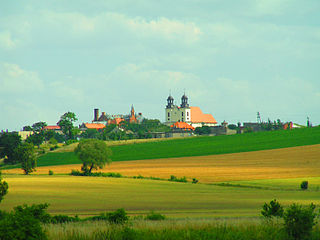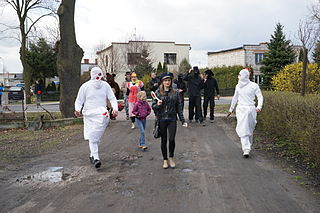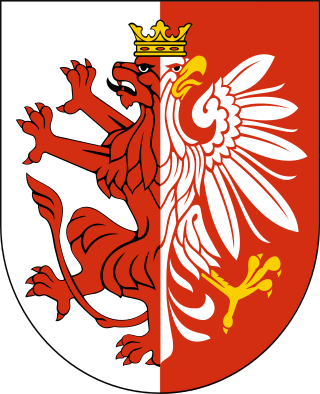
Poznań is a city on the River Warta in west Poland, within the Greater Poland region. The city is an important cultural and business centre, and one of Poland's most populous regions with many regional customs such as Saint John's Fair, traditional Saint Martin's croissants and a local dialect. Among its most important heritage sites are the Renaissance Old Town, Town Hall and Gothic Cathedral.

Greater Poland Voivodeship is a voivodeship, or province, in west-central Poland. The province is named after the region called Greater Poland or Wielkopolska. The modern province includes most of this historic region, except for some western and northern parts.

Kuyavia, also referred to as Cuyavia, is a historical region in north-central Poland, situated on the left bank of Vistula, as well as east from Noteć River and Lake Gopło. It is divided into three traditional parts: north-western, central, and south-eastern.

The Neumark, also known as the New March or as East Brandenburg, was a region of the Margraviate of Brandenburg and its successors located east of the Oder River in territory which became part of Poland in 1945 except some villages of former districts of Königsberg in the New March and Weststenberg remained in Germany.

Masovians, also spelled as Mazovians, and historically known as Masurians, is an ethnographic group of Polish people that originates from the region of Masovia, located mostly within borders of the Masovian Voivodeship, Poland. They speak the Masovian dialect of Polish.

Kuyavians is an ethnographic group of Polish people, that originate from the region of Kuyavia, located within the Kuyavian-Pomeranian Voivodeship and eastern Greater Poland Voivodeship in Poland. They speak the Kuyavian subdialect of the Greater Poland dialect cluster of Polish language. The group itself been influenced by nearby groups of Pomeranians and Greater Poland people.

Silesians is both an ethnic as well as a geographical term for the inhabitants of Silesia, a historical region in Central Europe divided by the current national boundaries of Poland, Germany, and Czechia. Historically, the region of Silesia has been inhabited by Polish, Czechs, and by Germans. Therefore, the term Silesian can refer to anyone of these ethnic groups. However, in 1945, great demographic changes occurred in the region as a result of the Potsdam Agreement leaving most of the region ethnically Polish and/or Slavic Upper Silesian. The Silesian language is one of the regional languages used in Poland alongside Polish as well as Kashubian and is structured with in a SVO format, however the grammar is quite often different to that of the other Lechitic languages. The names of Silesia in different languages most likely share their etymology—Polish: ; German: Schlesienpronounced[ˈʃleːzi̯ən] ; Czech: Slezsko ; Lower Silesian: Schläsing; Silesian: Ślōnsk ; Lower Sorbian: Šlazyńska ; Upper Sorbian: Šleska ; Latin, Spanish and English: Silesia; French: Silésie; Dutch: Silezië; Italian: Slesia; Slovak: Sliezsko; Kashubian: Sląsk. The names all relate to the name of a river and mountain in mid-southern Silesia, which served as a place of cult for pagans before Christianization.

The Greater Poland uprising of 1848 or Poznań Uprising was an unsuccessful military insurrection of Poles against forces of the Kingdom of Prussia, during the Revolutions of 1848. The main fighting in the Prussian Partition of Poland was concentrated in the Greater Poland region but some fighting also occurred in Pomerelia. In addition, protests were also held in Polish inhabited regions of Silesia.

The Gorals, also known as the Highlanders and historically also as Vlachs, are an ethnographic subgroup primarily found in their traditional area of southern Poland, northern Slovakia, and in the region of Cieszyn Silesia in the Czech Republic, where they are known as the Silesian Gorals. There is also a significant Goral diaspora in the area of Bukovina in western Ukraine and in northern Romania, as well as in Chicago, the seat of the Polish Highlanders Alliance of North America.

Kcynia is a town in Nakło County, Kuyavian-Pomeranian Voivodeship, in north-central Poland, with 4,702 inhabitants (2010). It is located in the Pałuki ethnographic region in the northern part of historic Greater Poland.

Poznań Voivodeship 14th century to 1793 was a unit of administrative division and local government in Poland from the 14th century to the Second Partition of Poland in 1793. It was part of the Greater Poland Province.

Kalisz Region is a historical and ethnographical area of Poland, located in central Poland mainly in the Greater Poland Lakes Area and South Greater Poland Plain. It forms the eastern part of Greater Poland proper.

The National Museum in Poznań, Poland, abbreviated MNP, is a state-owned cultural institution and one of the largest museums in Poland. It houses a rich collection of Polish painting from the 16th century on, and a collection of foreign painting. The museum is also home to numismatic collections and a gallery of applied arts.

Greater Poland, often known by its Polish name Wielkopolska, is a Polish historical region of west-central Poland. Its chief and largest city is Poznań followed by Kalisz, the oldest city in Poland.

Siwki or Siwek is a regional tradition rooted in Polish folklore, in which a procession of dressed up individuals stops passers-by and performs tricks on them. The event usually takes place on Easter Sunday or Easter Monday.

Kaliszans are members of an ethnographic group of Polish people from the Kalisz Region, located within the Greater Poland Voivodeship, Poland. They are part of the bigger ethnographic group of Greater Poland people.
Taśtaks is an ethnographic group of Polish people, and part of the bigger ethnographic group of the Greater Poland people. They inhabit the rural area around the Warta river near the Nowe Miasto nad Wartą, in the counties of Środa and Września, in the Greater Poland Voivodeship, Poland, notably including the villages of Czeszewo, Krzykosy, Lubrze, Orzechowo, Pięczkowo, and Witowo.

Łęczycans is an ethnographic group of Polish people that originate from the historical region of Łęczyca Land, located within borders of the Łódź Voivodeship, Poland. The group currently does not express much cultural separateness from other Poles. Historically, the group has been heavily inflected by the neighboring groups of Masovians, Greater Poland people, and Lesser Poland people.

Sieradzans is an ethnographic group of Polish people that originate from the historical region of Sieradz Land, located within borders of the Łódź Voivodeship, Poland. The group does not express much cultural separateness from other Poles. Historically, the group has been heavily inflected by the neighboring groups of Silesians, Greater Poland people, and Lesser Poland people.
Kuyavian Borowiaks is an ethnic subgroup of Kuyavians, who themselves are an ethnographic group of Polish people. They originate from the forest area of southern Kuyavia, located between the towns of Brdów, Przedecz, and Sompolno, within the counties of Koło and Konin, within the Greater Poland Voivodeship, Poland. They speak the Kuyavian subdialect of the Greater Poland dialect of Polish language. The group itself has inflected by nearby groups of Kashubians and Greater Poland people.



















